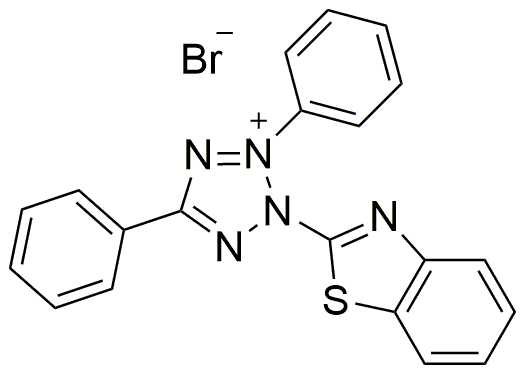2-(2-Benzothiazolyl)-3,5-diphenyltetrazolium bromide is widely utilized in research focused on:
- Cell Viability Assays: This compound is commonly used in laboratory settings to assess cell viability and proliferation. Researchers can easily determine the health of cells in culture, making it invaluable for drug testing and toxicology studies.
- Biochemical Research: It serves as a vital reagent in various biochemical assays, particularly in studies involving mitochondrial activity. Its ability to indicate metabolic activity helps scientists understand cellular processes.
- Pharmaceutical Development: In the pharmaceutical industry, it aids in screening potential drug candidates by providing insights into their effects on cell growth and survival, streamlining the drug discovery process.
- Environmental Toxicology: The compound is used to evaluate the impact of pollutants on living organisms, helping researchers assess ecological risks and develop strategies for environmental protection.
- Food Safety Testing: It can be applied in food microbiology to test the effects of preservatives and other additives on microbial growth, ensuring food safety and quality.
General Information
Properties
Safety and Regulations
Applications
2-(2-Benzothiazolyl)-3,5-diphenyltetrazolium bromide is widely utilized in research focused on:
- Cell Viability Assays: This compound is commonly used in laboratory settings to assess cell viability and proliferation. Researchers can easily determine the health of cells in culture, making it invaluable for drug testing and toxicology studies.
- Biochemical Research: It serves as a vital reagent in various biochemical assays, particularly in studies involving mitochondrial activity. Its ability to indicate metabolic activity helps scientists understand cellular processes.
- Pharmaceutical Development: In the pharmaceutical industry, it aids in screening potential drug candidates by providing insights into their effects on cell growth and survival, streamlining the drug discovery process.
- Environmental Toxicology: The compound is used to evaluate the impact of pollutants on living organisms, helping researchers assess ecological risks and develop strategies for environmental protection.
- Food Safety Testing: It can be applied in food microbiology to test the effects of preservatives and other additives on microbial growth, ensuring food safety and quality.
Documents
Safety Data Sheets (SDS)
The SDS provides comprehensive safety information on handling, storage, and disposal of the product.
Product Specification (PS)
The PS provides a comprehensive breakdown of the product’s properties, including chemical composition, physical state, purity, and storage requirements. It also details acceptable quality ranges and the product's intended applications.
Certificates of Analysis (COA)
Search for Certificates of Analysis (COA) by entering the products Lot Number. Lot and Batch Numbers can be found on a product’s label following the words ‘Lot’ or ‘Batch’.
Numéro de catalogue
Numéro de lot/série
Certificates Of Origin (COO)
This COO confirms the country where the product was manufactured, and also details the materials and components used in it and whether it is derived from natural, synthetic, or other specific sources. This certificate may be required for customs, trade, and regulatory compliance.
Numéro de catalogue
Numéro de lot/série
Safety Data Sheets (SDS)
The SDS provides comprehensive safety information on handling, storage, and disposal of the product.
DownloadProduct Specification (PS)
The PS provides a comprehensive breakdown of the product’s properties, including chemical composition, physical state, purity, and storage requirements. It also details acceptable quality ranges and the product's intended applications.
DownloadCertificates of Analysis (COA)
Search for Certificates of Analysis (COA) by entering the products Lot Number. Lot and Batch Numbers can be found on a product’s label following the words ‘Lot’ or ‘Batch’.
Numéro de catalogue
Numéro de lot/série
Certificates Of Origin (COO)
This COO confirms the country where the product was manufactured, and also details the materials and components used in it and whether it is derived from natural, synthetic, or other specific sources. This certificate may be required for customs, trade, and regulatory compliance.


